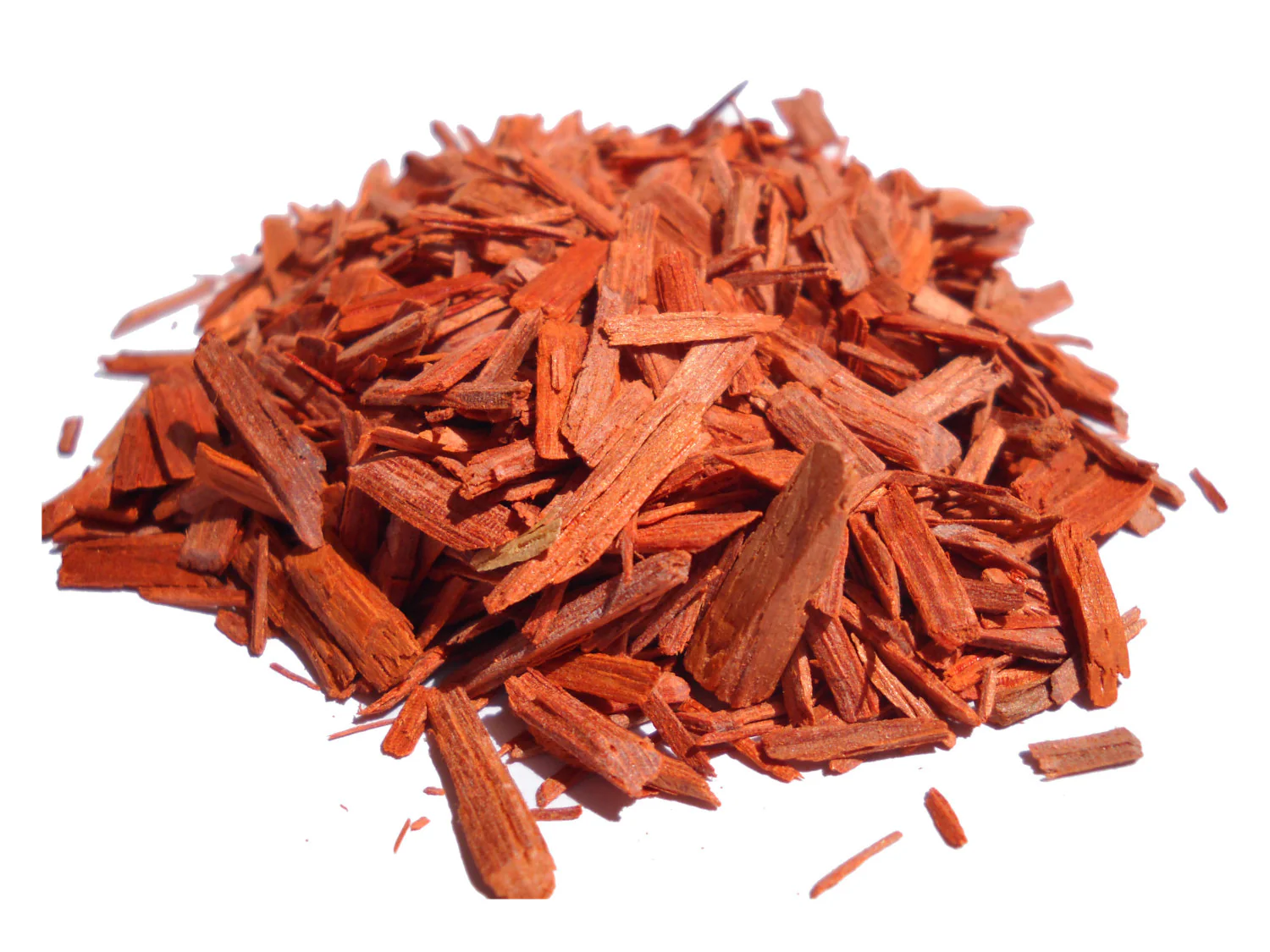What is Sandalwood?
Sandalwood is a fragrant wood obtained from trees in the genus Santalum. It is highly valued for its aromatic properties and is commonly used in perfumes, incense, and traditional medicine. Sandalwood is also used in religious rituals and carvings, especially in Indian and Southeast Asian cultures. The wood and its essential oil are known for their soothing, long-lasting fragrance.
Types
Sandalwood can also be classified based on the color of the wood, which is often linked to its species and properties. Here are the main types according to color:
White Sandalwood

- Species: Mainly Santalum album (Indian sandalwood) and Santalum spicatum (Australian sandalwood).
- Description: White sandalwood is the most common and prized type, known for its creamy, pale yellow to light brown color. It has a rich, smooth, and long-lasting fragrance, making it valuable for perfumes, incense, and essential oils. Indian sandalwood, in particular, is known for its sweet, woody aroma.
- Uses: Perfumery, cosmetics, incense, religious rituals, and medicinal uses.
Red Sandalwood

- Species: Pterocarpus santalinus (also called Raktachandan).
- Description: Unlike white sandalwood, red sandalwood is more valued for its deep red color rather than its fragrance. It has little to no aroma and is used mainly for its medicinal properties and wood dye. The wood is used in furniture and carvings due to its vibrant color.
- Uses: Ayurvedic medicine, dyes, woodcraft, and carvings.
Yellow Sandalwood

- Species: This term is often used loosely for high-quality Santalum album or for inferior sandalwood varieties with a yellowish hue.
- Description: Yellow sandalwood is closely associated with high-quality Indian sandalwood, where the heartwood is typically golden-yellow in color. However, some regions refer to less aromatic species with a yellow tint as yellow sandalwood.
- Uses: Perfumery, incense, traditional medicine, and religious purposes.
The classification by color is mostly for aesthetic and cultural reasons, but it is the aromatic properties of the wood that primarily determine its value. White sandalwood is generally considered the most valuable due to its fragrance.
What is it used for?
Sandalwood oil has a warm, woody odor and is commonly used as a fragrance in incense, cosmetics, perfumes, and soaps. It also is used as a flavor for foods and beverages. The wood has been valued in carving because of its dense character.
In traditional medicine, sandalwood oil has been used as an antiseptic and astringent, and for the treatment of headache, stomachache, and urinary and genital disorders. In India, the essential oil, emulsion, or paste of sandalwood is used in the treatment of inflammatory and eruptive skin diseases. The oil has been used in the traditional Ayurvedic medicinal system as a diuretic and mild stimulant, and for smoothing the skin. The leaves and bark were used by early Hawaiians to treat dandruff, lice, skin inflammation, and sexually transmitted diseases.
Forms

Sandalwood comes in various forms, each serving different purposes based on how it is processed and used. Here are the common forms of sandalwood:
- Sandalwood Essential Oil
- Sandalwood Powder
- Sandalwood Paste
- Sandalwood Chips
- Sandalwood Incense
- Sandalwood Soap
- Sandalwood Tablets/Capsules
- Sandalwood Hydrosol
Health Benefits
Sandalwood, especially its essential oil, offers several health benefits due to its anti-inflammatory, antiseptic, and calming properties. The top 5 health benefits of sandalwood are:
Anti-inflammatory Effects
Sandalwood is widely known for its ability to reduce inflammation, thanks to its active compounds like α-santalol and β-santalol. These compounds work by blocking the release of pro-inflammatory substances in the body, making sandalwood particularly useful in treating skin conditions like eczema, psoriasis, and dermatitis. Its application soothes irritated skin, reduces redness, and provides relief from sunburns and insect bites. In addition, it can be beneficial for those suffering from joint and muscle pain, as it helps alleviate swelling associated with inflammation.
Stress Relief and Anxiety Reduction
One of the most renowned benefits of sandalwood is its ability to relieve stress and reduce anxiety. Its calming, woody fragrance has long been used in aromatherapy to promote relaxation and emotional balance. Inhaling the scent of sandalwood triggers the release of neurotransmitters like serotonin, helping to calm the mind and reduce symptoms of anxiety. Many people incorporate sandalwood into their meditation practices or use it to create a peaceful atmosphere for relaxation and sleep.

Skin Care
Sandalwood’s benefits for the skin are remarkable. It is often found in skincare products due to its ability to soothe, hydrate, and rejuvenate the skin. Sandalwood oil helps reduce the appearance of wrinkles, dark spots, and scars, making it a popular anti-aging ingredient. Its antimicrobial properties also make it effective for treating acne and other skin conditions, preventing bacterial infections, and promoting faster healing of wounds or blemishes.
Aids in Sleep
In addition to its calming effects on the mind, sandalwood is known for its ability to improve sleep quality. Its sedative properties help relax the nervous system, making it easier to fall asleep and enjoy deep, restful sleep. People suffering from insomnia or those dealing with stress-related sleep disturbances often find relief through the use of sandalwood oil in diffusers or by applying it topically.
Antiseptic and Antimicrobial Properties
Finally, sandalwood’s natural antiseptic and antimicrobial properties make it effective in protecting the skin from infections. When applied to minor cuts, wounds, or blemishes, it helps prevent bacterial growth and accelerates the healing process. This makes sandalwood a versatile ingredient for treating acne and other skin conditions, as it not only prevents infection but also helps calm inflammation, leading to clearer and healthier skin.
Side Effects
While sandalwood is generally safe for most people, it can cause side effects in some cases. Topical application of sandalwood oil may lead to skin irritation or allergic reactions, especially in individuals with sensitive skin. It’s important to perform a patch test before extensive use. Ingesting sandalwood or its essential oil in large amounts can lead to gastrointestinal discomfort or other adverse effects. Pregnant or breastfeeding women should consult a healthcare professional before using sandalwood products. Always use sandalwood in moderation and consult with a healthcare provider if you experience any adverse reactions.




